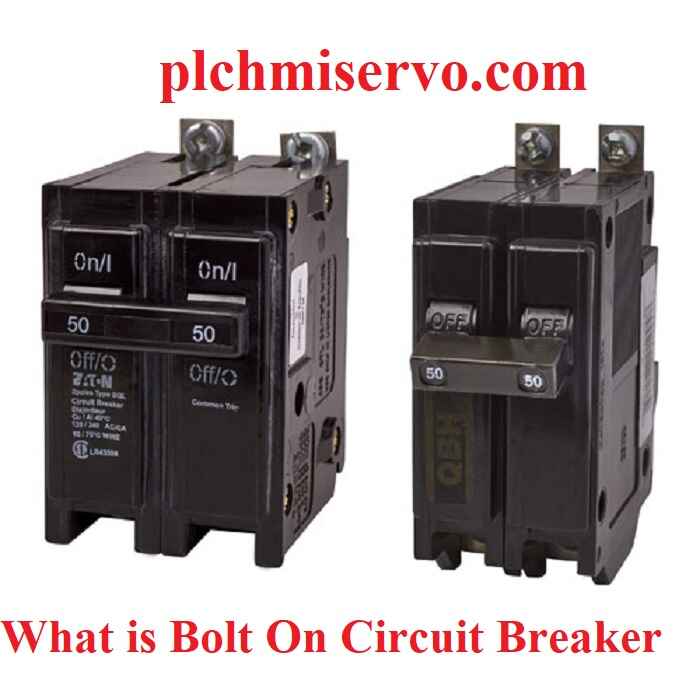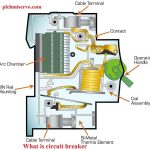What is Bolt On Circuit Breaker & Function of Bolt On Circuit Breaker
The Bolt On circuit breaker is a specific type of Miniature Circuit Breaker (MCB). This specific circuit breaker has a critical contribution on keeping electrical systems safe. The components of Bolt On MCB circuit breaker are engineered to detect and interrupt excessive current flow and short circuits. By doing so, MCBs serve a critical purpose: they shield electrical equipment, appliances, and wiring from harm that could result from these dangerous conditions. Moreover, these devices, they substantially lower the likelihood of electrical fires occurring, enhancing overall safety in buildings and homes.
The Bolt On Mechanism
The “Bolt On” describes the technique used to attach a Miniature Circuit Breaker (MCB) to a power distribution center or circuit breaker enclosure. This method involves physically bolting or fastening the MCB into place within the electrical system. Unlike their plug-in counterparts, which are inserted into slots, Bolt On MCBs are physically bolted or screwed onto the panel’s bus bars or mounting rails. This attachment method provides several advantages:
+1. Enhanced stability: The bolted connection ensures a more secure and permanent attachment, reducing the risk of accidental disconnection.
+2. Improved conductivity: The direct connection to bus bars often results in better electrical contact and reduced resistance.
+3. Higher current ratings: The robust attachment allows Bolt On MCBs to handle higher current loads compared to plug-in types.
+4. Increased safety: The secure mounting reduces the risk of arcing and overheating at connection points.
What is Bolt On Circuit Breaker Types and Configurations
Bolt On Circuit Breakers or MCBs are available in multiple configurations to meet diverse electrical system needs such as:
+1. Single-pole: Safeguards one energized wire. It’s frequently installed in homes and small business settings.
+2. Double-pole: Safeguards two live conductors, suitable for heavy-duty residential and commercial use.
+3. Three-pole: Protects three live conductors, typically found in industrial and large-scale commercial settings.
+4. Four-pole: Applied in three-phase electrical systems. It includes safety for the neutral line. This type is eligible for industrial environments.
Tripping Mechanism
The heart of a Bolt On Miniature Circuit Breaker is its tripping mechanism. This mechanism is designed to activate in response to various excessive current scenarios:
+1. Thermal trip element: This component uses a bimetallic strip that bends when heated by prolonged overcurrents. It’s designed to detect sustained overloads.
+2. Magnetic trip element: A solenoid activates in response to sudden high-current surges, such as those caused by short-circuits.
The combination of these elements ensures that the Bolt On circuit breaker can respond quickly to severe faults while also protecting against less dramatic but potentially damaging overloads.
Key Features and Benefits
+1. Resettable functionality: After tripping, Bolt On Circuit Breakers/MCBs can be manually reset once the fault is addressed, eliminating the need for replacement after each incident.
+2. Visual trip indication: Many models feature a visible indicator showing whether the breaker has tripped, aiding in fault diagnosis.
+3. Adjustable trip settings: Some advanced Bolt On MCBs allow for customization of trip thresholds to match specific application requirements.
+4. Compatibility with accessories: Many Bolt On MCBs can be equipped with auxiliary contacts, shunt trips, or other add-ons for enhanced functionality.
+5. Long service life: The robust construction and secure mounting contribute to extended operational lifespans.
What is Bolt On Circuit Breaker Installation and Maintenance
Proper installation of Bolt On MCB circuit breaker is crucial for their effective operation:
+1. Correct sizing: The MCB’s amperage rating must match the circuit’s requirements and comply with electrical codes.
+2. Proper torque: Bolts must be tightened to the manufacturer’s specifications to ensure good contact and prevent overheating.
+3. Regular inspection: Periodic checks is key to detecting indications of deterioration, harm, or insecure attachments before they become problems.
+4. Testing: Routine testing of the tripping mechanism helps ensure continued reliability.
Safety Considerations
benefits of Bolt On MCBs:
+1. Use certified products: Only install genuine, certified MCBs from reputable manufacturers.
+2. Follow codes and regulations: Adhere to the local codes of electricity and standards during installation and use.
+3. Regular maintenance: Conduct periodic inspections and tests to verify proper functioning.
The Bottom Line
The secure mounting, reliable operation, and versatility of circuit breakers make them an excellent choice for a wide range of applications, from residential settings to industrial environments. By understanding their features, benefits, and proper usage, electrical professionals can leverage these devices to create safer and more reliable electrical systems.

